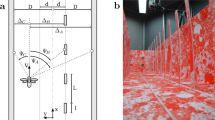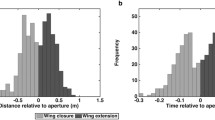Summary
-
1.
Using echolocation, bats move as gracefully as birds through the cluttered environment, suggesting common principles of optic and acoustic guidance. We tested the idea by analysing braking control of bats (Macroderma gigas) flying through a narrow aperture with eyes covered and uncovered.
-
2.
Though braking control would seem to require rapid detection of distance and velocity and computation of deceleration, simpler control is possible using the tau function of any sensory variable S that is a power function of distance to aperture. Tau function of S is τ(S) = S/S (the dot means time derivative). Controlled braking is achievable by keeping τ(S) constant.
-
3.
Previous experiments indicated the τ(S) constant procedure is followed by humans and birds in visually controlling braking. Analysis of the bats' flight trajectories indicated they too followed the braking procedure using echolocation.
-
4.
The tau function of echo-delay or of echo-intensity or of angle subtended by directions of echoes from two points on the approach surface could be used to control braking. Aperture size was modulated during flight on some trials in an attempt to test between these possibilities, but the results were inconclusive.
Similar content being viewed by others
References
Bastian J (1986) Electrolocation: behavior, anatomy and physiology. In: Bullock TH, Heiligenberg W (eds) Electroreception. Wiley, New York, pp 577–612
Bootsma RJ, van Wieringen PWC (1990) Timing an attacking for hand drive in table tennis. J Exp Psychol: Human Perception and Performance 16:21–29
Bullock TH, Heiligenberg W (eds) (1986) Electroreception. Wiley, New York
Griffin DR (1958) Listening in the dark. Yale University Press, New Haven
Griffin DR, Novick A, Kornfield M (1958) The sensitivity of echolocation in the fruit bat Rousettus. Biol Bull 115:107–113
Grinnell AD, Griffin DR (1958) The sensitivity of echolocation in bats. Biol Bull 114:10–22
Gustafson Y, Schnitzler HU (1979) Echolocation and obstacle avoidance in the hipposiderid bat Asellia tridens. J Comp Physiol 131:161–167
Kick SA, Simmons JA (1984) Automatic gain control in the bat's sonar receiver and the neuroethology of echolocation. J Neurosci 4:2725–2737
Lacquaniti F, Maiolo C (1989) The role of preparation in tuning anticipatory and reflex responses during catching. J Neurosci 9:134–148
Lee DN (1976) A theory of visual control of braking based on information about time-to-collision. Perception 5:437–459
Lee DN (1980) The optic flow field: The foundation of vision. Phil Trans R Soc London B 290:169–179
Lee DN (1991) Optic and acoustic constraints for action. In: Neisser U (ed) Ecological and interpersonal knowledge of the self. University Press, Cambridge, in press
Lee DN, Reddish PE (1981) Plummeting gannets: a paradigm of ecological optics. Nature 293:293–294
Lee DN, Young DS (1986) Gearing action to the environment. In: Heuer H, Fromm C (eds) Generation and modulation of action patterns. Springer, Heidelberg, pp 217–230
Lee DN, Lishman JR, Thomson JA (1982) Visual regulation of gait in long jumping. J Exp Psychol: Human Perception and Performance 8:448–459
Lee DN, Young DS, Reddish PE, Lough S, Clayton TMH (1983) Visual timing in hitting an accelerating ball. Q J Exp Psychol 35A:333–346
Lee DN, Reddish PE, Rand DT (1991) Aerial docking by hummingbirds. Naturwissenschaften 78:526–527
Moore BCJ (1989) An introduction to the psychology of hearing. Academic Press, London
Neuweiler G, Möhres FP (1967) Die Rolle des Ortsgedächtnisses bei der Orientierung der Grossblatt-Fledermaus Megaderma lyra. Z Vergl Physiol 57:147–171
Rosenblum LD, Carello C, Pastore RE (1987) Relative effectiveness of three stimulus variables for locating a moving sound source. Perception 16:175–186
Savelsbergh GJP, Whiting HTA, Bootsma RJ (1991) Grasping “tau”. J Exp Psychol: Human Perception and Performance 17:315–322
Schiff W, Detwiler ML (1979) Information used in judging impending collision. Perception 8:647–658
Schiff W, Oldak R (1990) Accuracy of judging time-to-arrival: Effects of modality, trajectory and gender. J Exp Psychol: Human Perception and Performance 16:303–316
Schnitzler HU (1973) Control of Doppler shift compensation in the greater horseshoe bat Rhinolophus ferrumequinum. J Comp Physiol 82:79–92
Schnitzler HU, Henson OW (1980) Performance of airborne animal sonar systems: I Microchiroptera. In: Busnel RG, Fish JF (eds) Animal sonar systems. Plenum, New York, pp 109–181
Sidaway B, McNitt-Gray J, Davis G (1989) Visual timing of muscle preactivation in preparation for landing. Ecol Psychol 1:253–264
Simmons JA (1989) A view of the world through the bat's ear: the formation of acoustic images in echolocation. Cognition 33:155–199
Simmons JA, Ferragamo M, Moss CF, Stevenson SB, Altes RA (1990) Discrimination of jittered sonar echoes by the echolocating bat, Eptesicus fuscus: the shape of the target images in echolocation. J Comp Physiol A 167:589–616
Suga N (1984) Neural mechanisms of complex-sound processing for echolocation. Trends Neurosci 7:20–27
Suga N (1988) Parallel-hierarchical processing of biosonar information in the mustached bat. In: Nachtigall PE, Moore PWB (eds) Animal sonar: processes and performance. Plenum Press, New York, pp 149–159
Todd JT (1981) Visual information about moving objects. J Exp Psychol: Human Perception and Performance 7:795–810
Tresilian JR (1990) Perceptual information for the timing of interceptive action. Perception 19:223–239
Wagner H (1982) Flow-field variables trigger landing in flies. Nature 297:147–148
Warren WH, Young DS, Lee DN (1986) Visual control of step length during running over irregular terrain. J Exp Psychol: Human Perception and Performance 12:259–266
Webster FA (1967) Some acoustical differences between bats and men. In: Dufton R (ed) International conference on sensory devices for the blind. St Dunstan's, London, pp 63–88
Author information
Authors and Affiliations
Rights and permissions
About this article
Cite this article
Lee, D.N., van der Weel, F.R.(., Hitchcock, T. et al. Common principle of guidance by echolocation and vision. J Comp Physiol A 171, 563–571 (1992). https://doi.org/10.1007/BF00194105
Accepted:
Issue Date:
DOI: https://doi.org/10.1007/BF00194105




